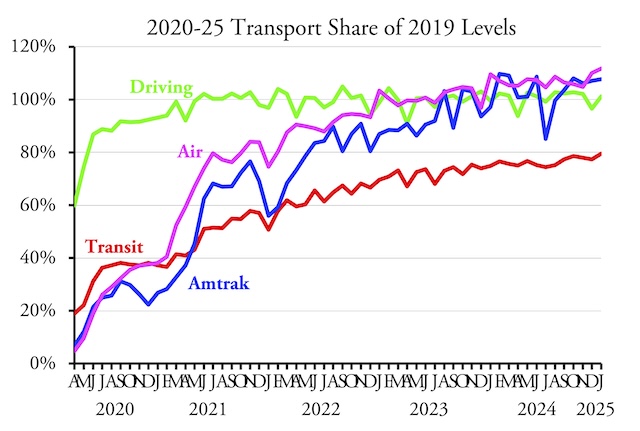Americans drove 1.2 percent more miles in January of 2025 than the same month in 2019, according to data released by the Federal Highway Administration yesterday. These data were posted less than a week after the agency released December traffic volume data, which for some reason were later than usual.
The data show that rural driving was up by 4.1 percent while urban driving was up by 0.1 percent. While driving on urban interstates and collector and local streets was up, driving on major urban arterials other than interstates was down. Some of this difference may be due to the way the Federal Highway Administration collects its data, which concentrates more on interstates and other arterials than on local streets. In other words, the driving numbers on local streets may be overestimated.
Relative to January 2019, driving increased the most in Rhode Island (44%!), South Dakota (24%), Montana (21%), Idaho (17%), and New Jersey (also 17%). Driving fell the furthest short of 2019 in the District of Columbia (-18%), West Virginia (-17%), Kentucky (also -17%), and Wyoming (-10%). Driving was actually up by 10 percent in California, a state where driving had been falling well short of 2019 levels in previous months.









“Congestion” is Orwellian Doublespeak for “traffic”
Yet Urbanists installed islands, narrowing avenues and lanes, cut access to streets for vehicles and reduced urban speed limits ALL lower vehicle thru-puts. Now wanna charge us to drive on roads they deliberately engineered for lower per hour thru puts? It’s like shooting someone in the leg, then saying, Look how slow you are, my brother across the street sells canes
“roads they deliberately engineered for lower per hour thru puts”
https://www.courthousenews.com/its-night-and-day-why-some-nyc-commuters-say-theyre-coming-around-to-congestion-pricing/
““I haven’t just accepted it — I’m willing to pay the toll for the increased quality of life that I get,” Vieba said, claiming that his commute time over the bridge has been slashed when he drives into Manhattan to visit friends and family.
Vieba said the daily traffic from the George Washington Bridge was “paralyzing” Fort Lee residents in recent years, to the point that he barely left his house. After congestion pricing took effect in January, Vieba says he can breathe again.
“I drive to a local store, and it’s been, no hyperbole, almost transformational,” Vieba said.”